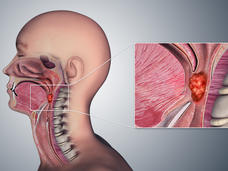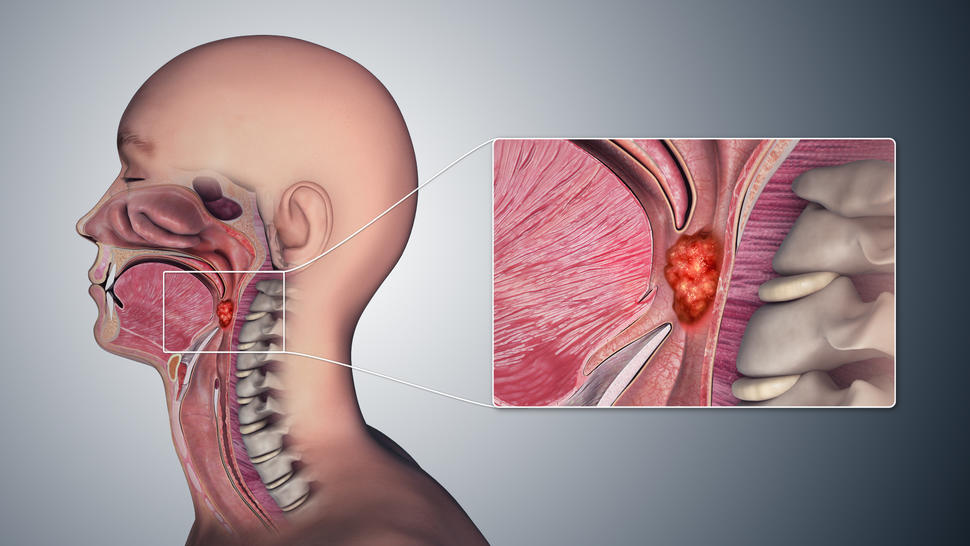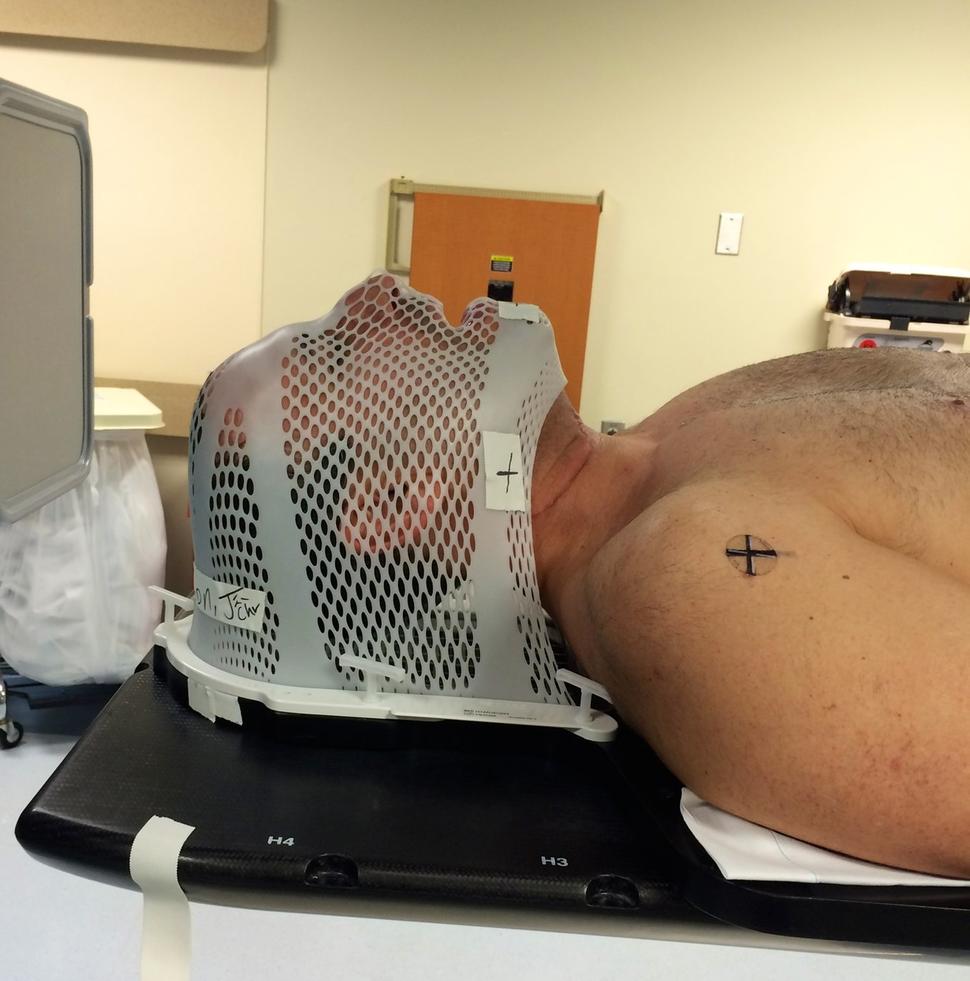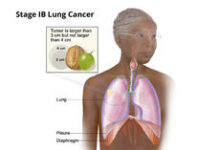, by NCI Staff
Imagine having such intense burns inside your throat that you don’t want to swallow. Instead, any saliva that you would normally swallow has to be spit out, into a big cup, over and over again, for weeks.
For a time in 2014, that was Jason Mendelsohn’s daily routine.
“The saliva in that cup was so thick, so viscous, that it wouldn’t go down the sink,” recounted Mendelsohn, who was diagnosed with oropharyngeal cancer at the age of 44.
Oropharyngeal cancer is a type of head and neck cancer that occurs in the back of the throat. Mendelsohn’s tumor was in his tonsils, the most common site of oropharyngeal cancer. The burns in his throat were the result of the radiation therapy he underwent as part of his treatment.
Before having radiation therapy, Mendelsohn underwent surgery to remove cancerous lymph nodes in his neck. And, in addition to radiation, he also received chemotherapy, which left him with burning and tingling toes and fingers (known as peripheral neuropathy) that persists—in a much milder form—some 7 years later.
In some ways, Mendelsohn represents the new reality of oropharyngeal cancer. Historically, oropharyngeal cancers were diagnosed largely in people in their 60s and 70s who were heavy smokers or drinkers. But starting in the mid-1990s, that began to change—dramatically. By the early 2010s, approximately 70% of diagnoses of oropharyngeal cancer were in people, predominantly White men, between the ages of 40 and 60. The culprit: the human papillomavirus, or HPV.
Mendelsohn’s cancer was HPV positive and now, at the age of 51, although he continues to experience some problems related to the treatments he received, he is largely healthy—and thriving. He runs his family business and is very active in the cancer advocacy community.
If there can be a silver lining to a cancer diagnosis, there was one with this shift in the cause of most oropharyngeal cancers: a much better prognosis.
Fewer than half of people diagnosed with oropharyngeal cancers linked to smoking and drinking live for more than 5 years. But it became clear more than a decade ago that those patients whose cancers are related to HPV do not have the same disease, explained Sue Yom, M.D., Ph.D., a radiation oncologist at the University of California, San Francisco, whose research focuses on new therapies for head and neck cancers.
“They had such a different survival than the patients we used to see before, so much more responsive to treatment,” Dr. Yom said. For many patients, the different treatments work so well that long-term survival, even cure, is now commonplace.
Like Mendelsohn, the large majority of people with HPV-related oropharyngeal cancer return to relatively good health within a year of completing treatment, Dr. Yom said. And treatment-related side effects are, unfortunately, an unavoidable part of the cancer experience.
In the case of oropharyngeal cancer, those side effects include extreme difficulty swallowing (which often requires the use of a feeding tube for a period), persistent dry mouth, debilitating dental problems, and hearing loss. For a small portion of patients, some of these problems will persist for many years.
Therein lies the rub of HPV-related oropharyngeal cancer, said Robert Ferris, M.D., Ph.D., the director of the UPMC Hillman Cancer Center in Pittsburgh, who specializes in treating head and neck cancers. The prognosis is excellent but, for some, the treatment can have a detrimental impact on their quality of life.
“Swallowing is something you take for granted until you don’t have it anymore,” Dr. Ferris said.
But is this trade-off necessary? Can some people with HPV-related oropharyngeal cancer—primarily those whose cancer hasn’t spread beyond the original tumor site—get less intensive treatment, decreasing their risk of short- and long-term therapy-related health problems without jeopardizing their likelihood of living a long, cancer-free life?
A host of studies have been examining the viability of treatment “deintensification,” as it’s often called. They have looked at lowering the dose of radiation therapy, skipping or lowering the amount of chemotherapy, whether robotic surgery can limit the need for other therapies, and, more recently, a potential role for immunotherapy.
“There are many ‘flavors’ of deintensification,” Dr. Ferris said. Now the goal is to figure out which are safest and most effective, and for which patients.
The Current Treatment Landscape for Oropharyngeal Cancer
At one time, traditional open surgery was a common treatment for oropharyngeal cancer, often followed by radiation and/or chemotherapy. However, this approach was not particularly effective at improving how long people lived. And open surgery required splitting the patient’s jaw, which caused severe, often disfiguring side effects and a high risk of death from treatment complications.
As a consequence, by the early 2000s, surgery had largely been supplanted by high-dose radiation therapy coupled with chemotherapy. This approach was as effective in treating the cancer, but it didn’t carry the baggage of disfigurement and fatality.
Then came the emergence of robotic surgery.
A form of minimally invasive surgery, robotic surgery usually requires just a few small incisions, into which a tiny camera and robotic arms with wrist-like appendages that can wield surgical instruments are inserted. The surgeon controls these components from a console in the operating room.
But unlike robotic surgery for other procedures, for cancers in the neck region, the camera and arms enter through a natural opening: the mouth. In 2009, the Food and Drug Administration approved the first such system for transoral robotic surgery, or TORS. A second TORS system was approved in 2015.
These systems offer “high-resolution binocular vision, magnified optics,” and ultra-maneuverable wrists “with 540 degrees of articulation,” Dr. Ferris said. Now, in a minimally invasive fashion, surgeons “can actually … remove the entire tumor.”
Fast forward to the present day, where robotic surgery followed by radiation therapy is now an additional standard of care for HPV-related oropharyngeal cancer, alongside radiation and chemotherapy, said Bhisham Chera, M.D., a radiation oncologist who specializes in head and neck cancers at the UNC Lineberger Comprehensive Cancer Center.
Although different factors can influence which of these treatment choices a patient is offered, Dr. Chera explained, the final decision is often a product of where a patient is being treated and the modality typically favored at that hospital or by their doctor.
The situation reflects a fortunate reality, Dr. Chera said. “Both surgery and radiation work for these patients … and they work equally well.”
Trials Look for Answers on Deintensification
The results of large randomized clinical trials are the gold standard of scientific evidence that typically leads to major shifts in how patients are treated. But only a few large randomized trials of treatment deintensification for people with HPV-related oropharyngeal cancer have been completed.
In two of these trials, researchers swapped out cisplatin—which has long been the standard chemotherapy for this cancer but can cause long-term side effects, like hearing loss—for cetuximab (Erbitux), a targeted therapy that is already used to treat advanced head and neck cancer and generally is less likely to cause long-term side effects.
In both trials, not only was there was no improvement in side effects in patients treated with cetuximab, they also were more likely to have their cancer come back and to die from the disease than those treated with cisplatin.
At the time the trial results were published, many doctors had already started using cetuximab in everyday care of patients with early-stage HPV-related disease, said Carole Fakhry, M.D., M.P.H., who directs the Head and Neck Cancer Center at Johns Hopkins Medicine.
One lesson from that experience, said Dr. Fakhry: “Don’t assume the outcome of a clinical trial.”
Some Good News from Smaller Clinical Trials
But there is some hopeful news on the treatment deintensification front as well, although it has come from smaller trials that were not randomized.
For example, a 114-patient trial led by Dr. Chera found that, in patients treated with lower doses of both radiation and chemotherapy, there was no difference in clinical outcomes to what is historically seen in patients treated with standard higher doses. However, serious side effects were much less frequent and severe. Similar results were seen in a randomized phase 2 trial led by Dr. Yom, called NRG HN002.
Several trials have also tested deintensification approaches involving robotic surgery. In a trial called ECOG 3311, led by Dr. Ferris, all trial participants initially underwent TORS. The intensity of any additional treatment they received was based on factors—such as size of the original tumor or extent of cancer in neck lymph nodes—that have been shown to predict whether the cancer is likely to spread or return.
Overall, about 70% of patients in the trial got less intensive treatment (e.g., lower doses of radiation or no chemotherapy) than the usual standard. At 2 years after surgery, nearly all patients in the trial were alive without any evidence that their cancer had returned.
Next Up: Immunotherapy and Biomarkers
A consistent theme in clinical trials of deintensified therapy for early-stage HPV-positive oropharyngeal cancer is the introduction of immunotherapy. That’s not surprising, Dr. Fakhry explained. Several immune checkpoint inhibitors are already approved to treat people with advanced forms of certain head and neck cancers, and other types of immunotherapy drugs have also shown promise for HPV-related cancers.
The premise is that immunotherapy, by providing a potential body-wide attack on any undetected cancer cells, might allow doctors to safely lower the dose of chemotherapy or radiation. A host of studies are ongoing, so “there’s no good answer” yet on where immunotherapy might fit in, Dr. Fakhry said.
One such trial is called NRG HN005, the follow-on from HN002. A much larger study, HN005 includes a group of patients who will receive a lower dose of radiation therapy followed by the immune checkpoint inhibitor nivolumab (Opdivo) instead of cisplatin.
Most of the other trials involving immunotherapy are smaller. At Hopkins, for example, Dr. Fakhry is involved in a soon-to-be-launched clinical trial in which all patients will initially receive low-dose chemotherapy and an immune checkpoint inhibitor.
The trial also involves another trend in treatment de-escalation studies: using a biomarker to guide treatment intensity. Following the initial treatment with chemotherapy and immunotherapy, the ensuing treatment that participants receive will depend in part on the levels of HPV DNA in their blood.
And researchers at Memorial Sloan Kettering Cancer Center are studying a different kind of biomarker. They recently reported promising results using the levels of oxygen in HPV-positive oropharyngeal tumors (measured using a PET scan) to direct the intensity of treatment. A larger study of the approach is currently enrolling patients.
Some Deintensification Is Already Happening
An already complex treatment landscape is made more complicated by the fact that, to a certain extent, treatment deintensification is already a part of everyday care.
That’s due, in part, to patients.
“You have patients who say, ‘I’m never taking chemo,’ ‘Don’t ever cut me,’ ‘Radiation, no way I’m having it,’” Dr. Yom explained. Some patients “have that bright line” of what treatments they do and don’t want, she said.
Still, some experts have urged caution in moving ahead too quickly with less intensive treatments before there is enough data on which to base those decisions.
In fact, one 2018 study, which looked at outcomes in patients with different stages of HPV-positive oropharyngeal cancer who had been treated in the past, provides support for that warning. In the study, patients who had been treated with only one modality, such as only high-dose radiation therapy or only surgery, did not live as long as those who received treatment with combinations of therapies that are aligned with current recommendations.
Drs. Yom and Fakhry both stressed that most patients in their practices receive one of the current standards of care, unless they are part of a clinical trial testing a deintensified approach. And that’s in keeping with patients’ wishes.
“When you ask patients what they want, they uniformly want cure,” Dr. Fakhry said.
Dr. Ferris noted that, in part, the move toward deintensification in everyday care has likely been driven by a 2018 change in the national criteria used to stage head and neck cancers. The change, which reflected the better prognosis of HPV-related cancers, meant that those who would have been diagnosed as stage 3 or 4 in the past are now considered to be stage 1.
Combine that shift with the different studies investigating deintensified treatments, Dr. Ferris said, and it’s not unexpected that some oncologists might start giving less treatment.
Even so, he is among those who believe that less treatment can produce cures—at least in the appropriate patients. He believes that, based on the data from the ECOG 3311 trial, robotic surgery alone or with lower doses of radiation is suitable for some low-risk patients. However, he stressed, the surgeon should have lots of experience with TORS.
“I think that any oncologist who wants to give more treatment has to show that [it] provides some sort of survival benefit for patients,” he said.
Dr. Chera agreed, noting that, for many patients, he routinely gives less radiation than the traditional standard.
“This is where reasonable people can disagree. I’m comfortable treating patients [outside of a clinical trial] with less radiation,” he said. “We’ve seen the outcomes with it. I already know this works.”
Important Discussions
None of this is to argue that clinical trials of treatment deintensification aren’t important, several researchers said. Trials are critical to providing more definitive answers about a multitude of unresolved issues, from how low radiation doses can go to which biomarkers best predict which patients need less or more intensive treatment.
It will take time to sort it all out, Dr. Yom cautioned.
“I think there’s going to be a very murky period where you have a lot of data … from trials that aren’t directly comparable, where the outcomes all seem reasonable, and the tradeoffs aren’t entirely clear,” she said. “There will have to be quite a bit of individualized counseling and transparency about the data with patients.”
Those discussions will be very important to patients, Mendelsohn stressed. Because of his involvement in the head and neck cancer advocacy community, he gets lots of questions from people newly diagnosed with the disease.
“I never give medical advice,” he said. “But I tell them to talk to their doctor and to really listen to the doctor.” Their oncologist may talk about possible options for less treatment or suggest participating in a clinical trial testing less intensive treatment.
Both options, Mendelsohn said, “should at least be part of the discussion.”









